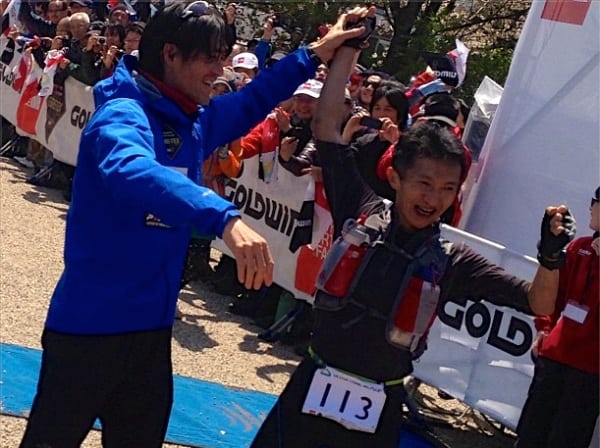A Japanese legend was born over the weekend as relatively unknown local ultra road runner Yoshikazu Hara finished first in the 2013 Ultra-Trail Mount Fuji ahead of Euro running stars Julien Chorier in second and Sebastien Chaigneau in third.
As Hara stormed past Chorier around the 60 kilometres mark in the iconic Japanese 100-miler, the question on everyone’s mind was, “Who’s Hara?” Though a proven Japanese ultra road runner (having represented Japan at the world and Euro 100k world champs and with a win in famous local race, the Lake Saroma 100k in 6:33:32), he was an unknown quantity over the technically demanding and steep trail around Mount Fuji.
The road runner’s six-minute lead over the 2012 UTMF winner Chorier seemed unsustainable – even Hara admitted later he had his doubts – but displaying the legendary Japanese warrior spirit he maintained the lead a third of the way in, then increased it, powering through to the finish in 19:38. “UTMF is a Japanese race,” he said to an ecstatic local crowd at the finish line, “and so a Japanese runner had to win.”

Yoshikazu Hara with Tsuyoshi Kaburaki after winning the 2013 UTMF. Photo: Rachel Jacqueline
Despite his bid to catch Hara over the more technical climbs, Chorier came to finish second nine minutes later in 19:48 (1 hour 8 minutes slower than his 2012 win on the same course but in a different direction). A triumphant Chaigneau followed two minutes later, stopping metres before the finish to swing his son onto his shoulders, turning to thank the crowd then walking across the finish line before embracing race director Tsuyoshi Kaburaki. Thirty minutes later, an exuberant Gary Robbins cruised over the finish in fourth place (full of smiles and seemingly too much energy), while Brendan Davies from Australia came in fifth, having given his all.
So how exactly did a diminutive, unsponsored local road runner beat some of the world’s best ultra trail runners at their own game?
As predicted, Chorier led from the start, together with Frenchman Cyril Cointre. Robbins, Davies, Hara, Jeremy Ritcey, Antoine Guillon, Chaigneau, Lionel Trivel, and Christophe Le Saux were all amongst the top ten during the first third of the race. At 55 kilometres Chorier had an eight-minute lead. But after a steady 25-kilometre ascent on road, Hara cruised into the next checkpoint five minutes ahead of Chorier. At the 89 kilometres checkpoint, Hara was still in front and declared he was determined to show the “soul of the Japanese.”
And so he did. By 122 kilometres, after a long descent down the ash slopes of Fuji at sunrise, Hara had a 13-minute lead over second place runner, then Robbins. After a short but unbelievably steep vertical ascent (described by runners as near rock-climbing in sections and like nothing they’ve seen before), his lead was still 12 minutes. With less than 20 kilometres to go, Chorier regained second place and Chaigneau overtook Robbins. A long stretch of road suited Hara and he stormed to the finish – a perfect end for the Japanese race.

Seb Chaigneau taking third at UTMF ’13. Photo: Rachel Jacqueline
According to Chorier, the race was much tougher than expected with several steep sections, followed by long “boring” flats, and without the long gradual ascents he’s used to effortlessly gliding over. Chaigneau described it as being incredibly steep and “harder than the UTMB.” Robbins said the race required “a full skill set” from climbing to road running, while fifth place Davies said it was “the toughest thing” he’s ever done. All unanimously agreed the race was epic.
Among the women, Krissy Moehl led the race early and stayed there throughout the 100 miles, ruthlessly increasing her lead despite Australian Shona Stephenson’s hot pursuit. Moehl finished in 24 hours 35 minutes; Stephenson came in just under an hour and half later, demonstrating the Aussie’s talent over long, grueling distances and cementing her place as one of Asia Pacific’s best female runners.
Japanese Hitomi Ogawa (who finished fifth in UTMF last year) improved this year to finish third, followed by local runners Kumiko Amikura (last year’s female winner of the UTMF sister race, the STY) and experienced Hiroko Suzuki from Salomon in fifth. Despite starting strong, Claire Price finished in eighth place after battling with injury for most of the second half of the race.
With the 2013 UTMF packed with edge-of-your seat suspense and displaying some serious ultrarunning talent, the 2014 edition already looks like it will be even more thrilling. With top road runners flocking to ultra trails and increasing the intensity of these races, the stakes seem to be getting higher. The question is: who will head to Fuji in 2014 to attempt to take the Japanese ultra crown?
2013 UTMF Men’s Results
- Yoshikazu Hara (Japan) – 19:39:48
- Julien Chorier (Salomon – France) – 19:48:28
- Sebastien Chaigneau (The North Face – France) – 19:50:13
- Gary Robbins (Salomon – Canada) – 20:20:39
- Brendan Davies (Inov-8 – Australia) – 20:38:17
- John Tidd (Uruguay) – 20:50:44
- Antoine Guillon (La Fuma – France) – 21:04:44
- Koiji Yamaya (Japan) – 21:05:12
- Cyril Cointre (Hoka One One – France) – 21:10:16
- Lionel Trivel (France) – 21:10:16
…
16. Grant Guise (Salomon – New Zealand)
Jeremy Ritcey pulled out at 105km with injury after spending most of the race in the front pack.

The top men from the 2013 Ultra-Trail Mt. Fuji. Photo: DogsorCaravan.com
2013 UTMF Women’s Results
- Krissy Moehl (Patagonia/Ultraspire – USA) – 24:35:45
- Shona Stephenson (Inov-8 – Australia) – 25:56:52
- Hitomi Ogawa (Patagonia/Vasque – Japan) – 26:15:25
- Kumiko Amikura (Japan) – 27:26:33
- Hiroko Suzuki (Japan) (Salomon) – 27:52:06
- Akemi Ban (Japan) – 27:52:27
- Chiaki Fjelddahl (Hong Kong) – 28:43:59
- Claire Price (Salomon – Hong Kong) – 29:37:08
- Matsuura Mayumi (Japan) – 31:53:29
- Yoshiko Takahashi (Japan) – 32:20:14

The top women from the 2013 Ultra-Trail Mt. Fuji. Photo: DogsorCaravan.com
